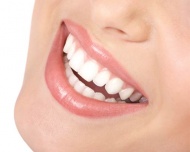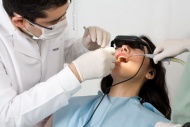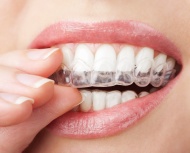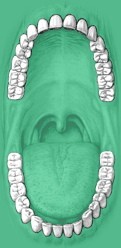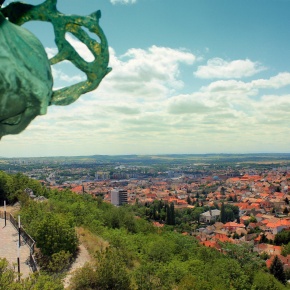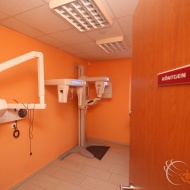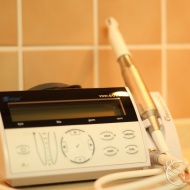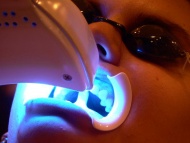
People with stained or dull teeth usually benefit from whitening, which is a safe and effective way to brighten stained, discolored or dull teeth. Even a single tooth that is noticeably duller or less white than your other teeth –generally because of root canal treatment- can be individually brightened.
Professional teeth bleaching products, which contain peroxides, actually change your natural tooth color anywhere from five to seven -- but even up to twelve -- shades brighter.
Causes of discoloration:
- Tetracyclines
- Enamel hypoplasia
- Fluorosis
- Age of the tooth: the teeth become more yellow or opaque and generally have a darker hue, usually after 50.
- Tea
- Coffee
- Smoking
- Mate
- Wine and cola drinks consumed in excess
- Other foods and oral tobacco products with strong content of pigments
- Chlorhexidine
In-office
In-office bleaching procedures generally use a light-cured protective layer that is carefully painted on the gums and papilla to reduce the risk of chemical burns to the soft tissues. The bleaching agent is either carbamide peroxide, which breaks down in the mouth to form hydrogen peroxide, or hydrogen peroxide itself. The bleaching gel typically contains between 10% and 44% carbamide peroxide, which is roughly equivalent to a 3% to 16% hydrogen peroxide concentration.
Light-accelerated bleaching
Power or light-accelerated bleaching, sometimes colloquially referred to as laser bleaching uses light energy to accelerate the process of bleaching in a dental office. Different types of energy can be used in this procedure, with the most common being halogen, LED, or plasma arc. Lights are typically within the blue light spectrum as this has been found to contain the most effective wavelengths for initiating the hydrogen peroxide reaction. A power bleaching treatment typically involves isolation of soft tissue with a resin-based, light-curable barrier, application of a professional dental-grade hydrogen peroxide whitening gel (25-38% hydrogen peroxide), and exposure to the light source for 6–15 minutes. Recent technical advances have minimized heat and ultraviolet emissions, allowing for a shorter patient preparation procedure. Most power teeth whitening treatments can be done in approximately 30 minutes to one hour, in a single visit to a dental physician.
At home
Commercial whitening products intended for home use include gels, chewing gums, rinses, toothpastes, among others.
High-concentration home bleaching uses carbamide peroxide. Whitening is performed by applying a high concentration of oxidizing agent to the teeth with thin plastic trays for a short period of time, which produces quick results. The application trays ideally should be well-fitted to retain the bleaching gel, ensuring even and full tooth exposure to the gel. Trays will typically stay on the teeth for about 15–20 minutes. Trays are then removed and the procedure is repeated up to two more times. Low-concentration whitening is far less effective. Low-concentration whitening involves purchasing a thin mouth guard or strip that holds a relatively low concentration of oxidizing agent next to the teeth for as long as several hours a day for a period of 5 to 14 days. Results can vary, depending on which application is chosen, with some people achieving whiter teeth in a few days, and others seeing very little results or no results at all. Dentists as well as some dental laboratories can make custom fitted whitening trays that will greatly improve the results achieved with an over-the-counter whitening method.

